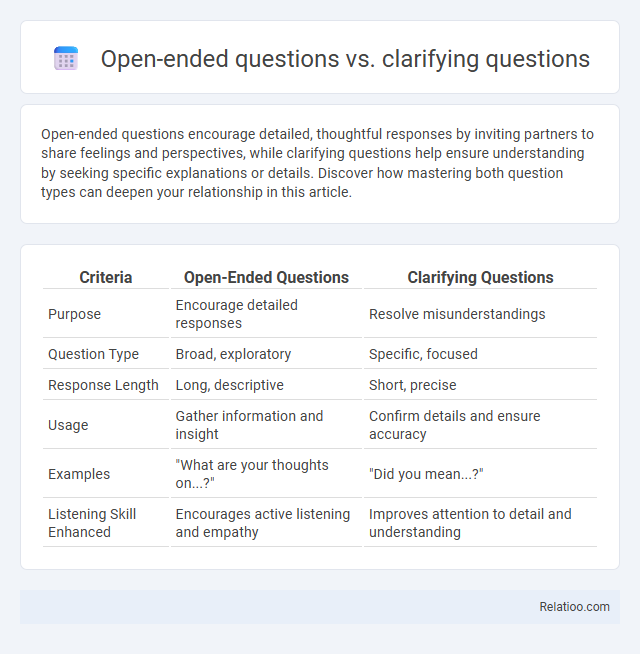Open-ended questions encourage detailed, thoughtful responses by inviting partners to share feelings and perspectives, while clarifying questions help ensure understanding by seeking specific explanations or details. Discover how mastering both question types can deepen your relationship in this article.
Table of Comparison
| Criteria | Open-Ended Questions | Clarifying Questions |
|---|---|---|
| Purpose | Encourage detailed responses | Resolve misunderstandings |
| Question Type | Broad, exploratory | Specific, focused |
| Response Length | Long, descriptive | Short, precise |
| Usage | Gather information and insight | Confirm details and ensure accuracy |
| Examples | "What are your thoughts on...?" | "Did you mean...?" |
| Listening Skill Enhanced | Encourages active listening and empathy | Improves attention to detail and understanding |
Understanding Open-Ended Questions
Open-ended questions encourage detailed responses by inviting you to share thoughts, feelings, and experiences rather than simple yes/no answers, fostering deeper understanding and richer conversations. Clarifying questions serve to narrow down or specify information by seeking explanations or examples, ensuring you accurately grasp the speaker's message. Mastering open-ended questions enhances communication skills and supports meaningful dialogue in personal and professional interactions.
Defining Clarifying Questions
Clarifying questions aim to eliminate confusion by seeking specific information, ensuring a clear understanding of the topic or statement. Unlike open-ended questions that encourage expansive responses, clarifying questions are targeted and precise, prompting elaboration or detail where ambiguity exists. Effective use of clarifying questions enhances communication accuracy and reduces misunderstandings in conversations or research.
Key Differences Between Open-Ended and Clarifying Questions
Open-ended questions invite detailed responses, encouraging exploration and insight, while clarifying questions are designed to verify understanding and obtain specific information. Open-ended questions often begin with "how," "why," or "what," fostering broader discussions, whereas clarifying questions focus on resolving ambiguity or confusion in previous statements. You can leverage these differences to enhance communication effectiveness by using open-ended questions for depth and clarifying questions for precision.
Benefits of Open-Ended Questions
Open-ended questions encourage detailed responses, fostering deeper understanding and richer communication by allowing individuals to express their thoughts freely. Unlike clarifying questions, which seek specific information for clarity, open-ended questions stimulate critical thinking, creativity, and comprehensive insights in conversations, interviews, or research. This approach enhances engagement and uncovers nuanced perspectives that closed or clarifying questions might overlook.
Advantages of Clarifying Questions
Clarifying questions help you gain precise understanding by eliminating ambiguity and ensuring accurate communication. These questions enhance problem-solving by targeting specific details and reducing misunderstandings in conversations. Using clarifying questions fosters more effective dialogue, which improves collaboration and decision-making processes.
When to Use Open-Ended Questions
Open-ended questions are essential when you want Your conversation partner to elaborate, share detailed experiences, or express thoughts freely, fostering deeper understanding. Use open-ended questions during initial interviews, brainstorming sessions, or counseling to encourage expansive dialogue and uncover underlying motivations. Clarifying questions, in contrast, are best used to ensure accuracy and understanding after an open-ended response, while closed-ended questions typically solicit brief, specific answers.
Appropriate Scenarios for Clarifying Questions
Clarifying questions are essential in scenarios where information appears ambiguous, incomplete, or confusing, helping to ensure accurate understanding before proceeding. Your use of clarifying questions is most effective during meetings, interviews, or complex discussions where precise details are critical for decision-making. Unlike open-ended questions that encourage broad elaboration, clarifying questions target specific points to eliminate misunderstandings and confirm facts.
Impact on Communication Outcomes
Open-ended questions encourage expansive responses, fostering deeper understanding and richer communication outcomes by allowing individuals to express thoughts freely. Clarifying questions target specific information, reducing misunderstandings and ensuring accuracy in the exchange. Your ability to balance these types enhances dialogue effectiveness, promoting both comprehensive insight and clear, precise communication.
Common Mistakes in Questioning Techniques
Common mistakes in questioning techniques include confusing open-ended questions with clarifying questions, leading to vague or incomplete answers. Open-ended questions encourage detailed responses and insights, while clarifying questions seek specific information to clear up confusion. You can improve communication by mastering the distinction between these types and avoiding mixed or poorly framed questions.
Best Practices for Effective Questioning
Open-ended questions encourage detailed responses by prompting deeper thinking and elaboration, essential for gathering comprehensive insights. Clarifying questions are used to confirm understanding and eliminate ambiguities, ensuring accurate communication. Employing a strategic blend of open-ended and clarifying questions optimizes conversation flow, enhances information accuracy, and fosters meaningful dialogue in interviews, coaching, and customer interactions.

Infographic: Open-ended questions vs Clarifying questions
 relatioo.com
relatioo.com